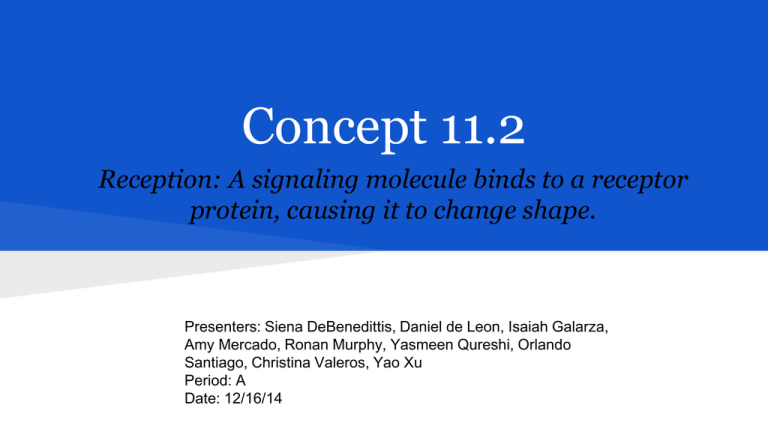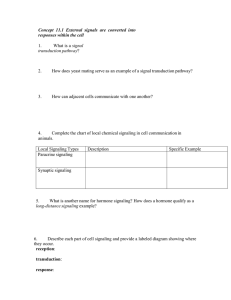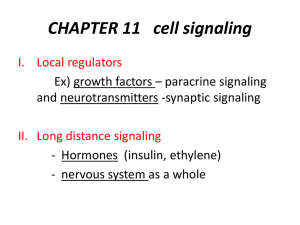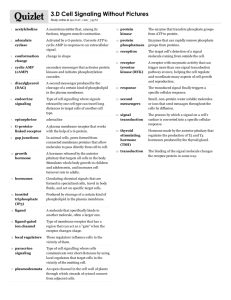Concept 11.2 Reception: A signaling molecule binds to a receptor
advertisement

Concept 11.2 Reception: A signaling molecule binds to a receptor protein, causing it to change shape. Presenters: Siena DeBenedittis, Daniel de Leon, Isaiah Galarza, Amy Mercado, Ronan Murphy, Yasmeen Qureshi, Orlando Santiago, Christina Valeros, Yao Xu Period: A Date: 12/16/14 Reception -The term used to describe the target cell’s detection of a signaling molecule outside of the cell. -This detection occurs when the signaling molecule binds to a certain site on the receptor protein. Ligands -Ligands are molecules that specifically bind to others. -Ligand bonding usually causes the receptor proteins to change shape. -This shape change could either: -allow the receptor to interact with other cellular molecules -or bring together two or more receptor molecules Intracellular Receptors. -Intracellular receptor proteins are found in the cytoplasm or nucleus of target cells. -Signaling molecules, a.k.a. chemical messengers can permeate through the membrane to reach these receptors Signaling molecules are hydrophobic or small enough to cross the membrane. For example: Steroid or thylakoid hormones are hydrophobic, and therefore can cross the membrane. Nitric acid (NO) is a molecule small enough to cross the membrane -Hormones like the steroid testosterone have the ability to bind to a receptor protein, activating it. The receptor protein then enters the nucleus and can turn on specific genes. -Special proteins called transcription factors are able to turn on specific genes, that it is able to turn on genes that are to be transcripted to mRNA. -The testosterone receptor which acts as a transcription factor carries out complete transduction of the signal. -Almost all other intracellular receptors function the same, but the only difference here is that the signal molecule reaches these receptors when they are in the nucleus. -Many intracellular receptors are similar in structure. Receptors in the Plasma Membrane -Receptor proteins embedded in the cell membrane contain sites onto which many water-soluble signal molecules are able to bind to. -These receptors transmit information into the cell when a ligand binds to it. -There are three types of receptors in the plasma membrane: G protein-linked receptors, receptor tyrosine kinases, and ion channel receptors. G Protein-Coupled Receptors (GPCRs) - - - A G protein-coupled receptor is a receptor protein located within the plasma membrane that functions along with the help of a G protein. A G protein is a protein that binds GDP and a phosphate group to form GTP, an energy rich molecule that functions similar to ATP. GPCRs are all made up of a single polypeptide chain coiled into seven α helices that span the plasma membrane. Slight changes in basic structure creates different GPCRs that bind to different signaling molecules and G proteins. GPCRs Cont. FUNCTIONS OF GPCRs GPCRs are extremely diverse in their functions -Has a role in embryonic development and sensory reception -In humans, taste, smell and vision all depend on these systems -Involved in many human diseases, mainly bacterial infections ~Cholera, pertussis, botulism, and other bacteria produces toxins that interfere with G proteins G Protein- Coupled Receptor 1) GDP is inactive. 2) A signalling molecule binds to the extracellular side of the receptor, making it active. GTP binds to the cytoplasmic side. 3) GTP moves to the enzyme, changing the enzyme’s shape and activity. It leads a cellular response. 4) The GTP leaves the enzyme and changes to GDP, which is now inactive. Receptor Tyrosine Kinases (RTKs) - Receptor tyrosine kinases belong to a major class of plasma membrane receptors. These receptors are characterized by enzymatic activity. - A kinase is an enzyme that catalyzes the transfer of phosphate groups. - The part of the receptor protein going inside the cytoplasm functions as a tyrosine kinase, an enzyme that catalyzes the transfer of a phosphate group from ATP to the amino acid tyrosine. RTKs continued. - One receptor tyrosine kinase complex can activate ten or more different transduction pathways and cellular responses, helping the cell regulate growth and reproduction. The ability of a single ligand-binding event to trigger so many pathways is a key difference between receptor tyrosine kinases and G protein-coupled receptors. Abnormal RTKs that operate in the absence of signaling molecules are related with many kinds of cancer. Receptor Tyrosine Kinases 1) There are two inactive monomers. 2) Signaling molecules go to the binding site. The two monomers come together and form a Dimer. 3) Dimerization activates the tyrosine region of each monomer. Each tyrosine kinase adds a phosphate from an ATP molecule to a tyrosine on the tail of the other monomer. 4) The receptor is activated. Proteins bind to a specific phosphorylated tyrosine, undergoing a structural change. It leads to a cellular response. Ion Channel Receptors - A ligand-gated ion channel is a membrane receptor containing a region that acts as a "gate" when the receptor changes shape. -Binding of a signaling molecule to a receptor protein causes the gate to open or close, allowing or blocking the flow of ions. -Important to the nervous system → Neurotransmitters released at a synapse between two nerve cells bind as ligands to ion channels, causing the channel to open. Ions flow in/out, triggering an electrical signal. -Voltage-gated ion channels are gated ion channels controlled by electrical signals instead of ligands. Ion Channel Receptors 1) The ligand-gated ion channel remains closed until a ligand binds to the receptor. 2) The ligand binds to the receptor. The gate opens and ions can flow through. It leads cellular response. 3) The ligand leaves the receptor. The gate closes and the ions can not pass through. Thanks :)







